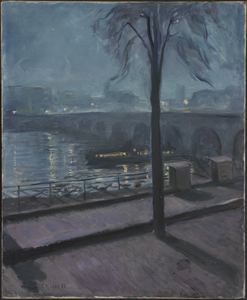Today’s post comes from Kristina Arike, class of 2014 and Art Center Student Docent.

On February 28, Mita Choudhury, Associate Professor of History, presented this semester’s final installment of the Artful Dodger. The subjects of her discussion were two seventeenth-century Dutch portraits painted by Paul Lesire, “Alida Pietersdr. Van Scharlaken, aged 25, 1637” and “Portrait of Reynier Johnsz., Aged 32, 1637”.
Professor Choudhury began with an explanation of how she came to select these paintings. She explained that she has always been interested in portraits and faces; while in London studying abroad in her undergraduate years, she often went to the National Portrait Gallery to visit the paintings, as if they were old friends. She also has fond memories of the family portrait photography in her paternal grandmother’s house in India.
It was this sort of close looking and questioning that fascinated her about portraiture: Who were these people? What were they thinking? What were their lives like? Why was the portrait made? For the purposes of this discussion, the most important question is: What do these portraits say about the societies in which they were produced?
Professor Choudhury provided some background in order to frame our reading of the painting. These paintings were meant to be a pair because they were marriage portraits and painted for the special occasion. Lesire painted Alida and Reynier during the period known as the Dutch Golden Age. During the seventeenth century, the Dutch Republic was economically prosperous. The Dutch were engaged in commerce and had an urban economy, whereas most of Europe was predominantly rural at that time. Alida and Reynier lived in Dordrecht, which was the third largest city of the Dutch Republic. Although it was eclipsed by other cities like Amsterdam, Dordrecht was still a thriving urban center. Alida and Reynier were at the fringe of the urban elite, the regents who governed Dordrecht. Reynier was a wealthy merchant and Alida came from an old patrician family.
Professor Choudhury explained the importance of the merchant class to artistic development in the Dutch Republic. They were able to commission work, which created an artistic environment which was market driven. This was a new model that did not depend on patronage; rather, it was more speculative and led painters to develop specializations. This model also challenges contemporary conceptions of what we think defines an artist. In the seventeenth-century Dutch Republic, artists were considered highly skilled artisans and belonged to guilds. Guilds point to the commercialized aspect of art in early modern Europe. The Guild of St. Luke, of which Lesire was a part, was the guild for painters and included the likes of Johannes Vermeer. Lesire was dependant on his patrons, and had a reputation for painting patricians.
It was Alida and Reynier’s powerful economic connection that allowed these portraits to exist. Paintings were a way to establish one’s lineage, and create a position of power for future descendants. They were also seen as a means of fixing one’s political position. Professor Choudhury pointed out the expressions of Alida and Reynier: stoic, mouth closed. These facial cues reflected the prevailing ideology of how civilized people should carry themselves, and also affirmed their right to govern.
The presentation ended with a lively discussion of the paintings between the audience and Professor Choudhury. An interesting detail noted was Alida’s posture—specifically, her jutting elbow that resembles the famed “Renaissance elbow.” This pose was a convention used as an assertion of masculinity. Viewers of the period would have recognized the significance of this gesture and read it as a way of her asserting the prominence of her family.





It’s true that the painting is stoic, but it’s also so lifelike, so present. It really was considered highly indecorous in this time to open up in a full smile and show your teeth – but on the other hand this is not a stern lady showing her “right to govern.” She seems so amiable! Looking at this portrait, I almost can’t believe I’m looking at a person who lived 400 years ago – she’s looking at the viewer with such attentiveness and animation.
Today in the Museum Studies Seminar we got to look at this portrait and the its companion under ultraviolet light to see the careful restoration that had been completed. They are great examples of how restorers may only partially clean old varnish off of a painting, as older varnish was left on the black clothes of the subject due to the delicate nature of its treatment.
This Dutch Golden Age portrait reminds me of another work we have in our collection, the “Old Woman Drinking.” Though more of a caricature than a portrait, this other work shows us a flip-side to the genteel society portrayed in the wedding portraits. But Ani’s right, Lady Alida looks like she might enjoy the company of the Old Woman, there’s a sneaky cheerfulness about her!
Can I just say what a reduction to find someone who truly is aware of what theyre speaking about on the internet. You definitely know methods to convey an issue to light and make it important. More folks need to read this and perceive this aspect of the story. I cant imagine youre no more popular because you definitely have the gift.
I’m impressed, I have to say. Actually rarely do I encounter a blog that’s both educative and entertaining, and let me let you know, you’ve hit the nail on the head. Your thought is outstanding; the difficulty is something that not enough persons are speaking intelligently about. I’m very completely satisfied that I stumbled throughout this in my seek for one thing referring to this.